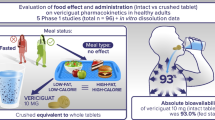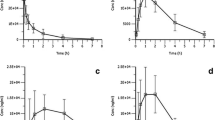Abstract
Oral bioavailability of highly water-insoluble drugs is often quite limited and variable, requiring the development of improved formulations. Animal models are an essential aspect of the design and testing of such formulations designed to improve absorption in man. The present report compares the absorption of CGS-20625, an insoluble drug, in dog and man after oral administration of the drug as a powder, a solid dispersion capsule, and after gastric and duodenal administration in PEG 400 solution. CGS-20625 powder (20 mg) given orally exhibited slow, delayed absorption in both dog and man, with aC max of 0.26±0.07 μg/ml atT max of 3 hr in dog, and 0.01±0.004 μg/ml at 2 hr in man. Administration of CGS-20625 in PEG 400 solution improved absorption in dog and man, with aC max of 1.2±0.10 μg/ml atT max of 0.25 hr in dog, and aC max of 0.10±0.04 μg/ml at 0.5 hr in man.T max after administration of the hard gelatin capsule formulation was 0.9 and 1.0 hr in dog and man, withC max of 0.89±0.16 and 0.052±0.014 μg/ml, respectively. Absolute bioavailability of CGS-20625 powder in the dog was 0.67±0.21, whereas the bioavailabilities of the powder and the capsule relative to the PEG 400 solution were 0.84 and 1.1, respectively, in dog, and 0.41 and 0.85 respectively, in man. No significant benefits of duodenal administration were observed. Plasma levels were approximately 10-fold greater and oral clearance was approximately 5-fold less in the dog than in man. Furthermore, pharmacokinetic data were less variable and relative bioavailability was greater in dogs than in humans. Physiological factors in the gastrointestinal tract or greater first-pass metabolism in man may account for these species differences. The relative rate and extent of CGS-20625 absorption were similar between dog and man, in the order of powder <capsule<PEG 400 solution. In addition,in vivo absorption rates in both species reflectin vitro dissolution differences between the powder and the capsule. These data strongly support the use of the dog as a model for developing improved formulations of CGS-20625. Further investigation of the dog as a model to evaluate insoluble drug absorption is warranted.
Similar content being viewed by others
References
W. A. Cressman and D. Sumner. The dog as a model for evaluation of nondisintegrating sustained-release tablets.J. Pharm. Sci. 60:132–134 (1971).
T. T. Kararli and J. Stolzenbach. Rate-limiting steps in oral absorption of a leucotriene D4 antagonist in the beagle dog.J. Pharm. Sci. 81:875–878 (1992).
E. Rosen, T. Ellison, P. Tannenbaum, S. M. Free, and A. P. Crosley, Jr. Comparative study in man and dog of the absorption and excretion of dextroamphetamine-14C sulfate in sustained-release and nonsustained-release dosage forms.J. Pharm. Sci. 56:365–369 (1967).
J. B. Dressman. Comparison of canine and human gastrointestinal physiology.Pharm. Res. 3:123–131 (1986).
C. Y. Lui, G. L. Amidon, R. R. Berardi, D. Fleisher, C. A. Youngberg, and J. B. Dressman. Comparison of gastrointestinal pH in dogs and humans: Implications on the use of the beagle dog as a model for oral absorption in humans.J. Pharm. Sci. 75:271–274 (1986).
L. A. Brunner and R. C. Luders. Determination of a potential anxiolytic drug (CGS 20625) in human plasma by high-performance liquid chromatography.J. Chromatog. 568:487–493 (1991).
U.S. Pharmacopeia XXI.NF XVI, US Pharmacopeial Comvention Inc., Rockville, MD, 1985, p. 1243.
Statistical Consultants, Inc. PCNONLIN and NONLIN: software for the statistical analysis of nonlinear models.Am. Statist. 40:52 (1986).
J. G. Wagner.Fundamentals of Clinical Pharmacokinetics. Drug Intelligence Publications, Inc., Hamilton, IL, 1979, p. 71.
J. C. K. Loo, and S. Riegelman. New method for calculating the intrinsic absorption rate of drugs.J. Pharm. Sci. 57:918–928 (1968).
Author information
Authors and Affiliations
Rights and permissions
About this article
Cite this article
Hirschberg, Y., Oberle, R.L., Ortiz, M. et al. Oral absorption of CGS-20625, an insoluble drug, in dogs and man. Journal of Pharmacokinetics and Biopharmaceutics 23, 11–23 (1995). https://doi.org/10.1007/BF02353783
Received:
Accepted:
Published:
Issue Date:
DOI: https://doi.org/10.1007/BF02353783




